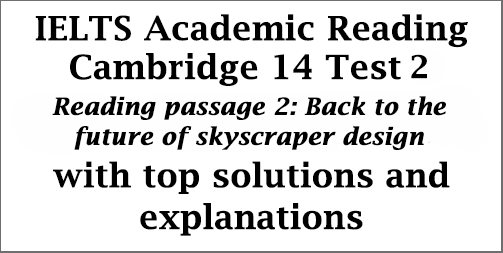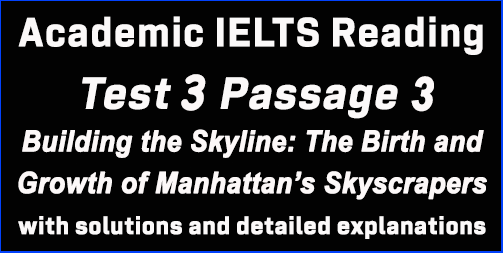IELTS Academic Reading: Cambridge 14, Reading Test 2: Passage 2; Back to the future of skyscraper design; with top solutions and detailed explanations
This IELTS Reading post focuses on all the solutions for IELTS Cambridge 14 Reading Test 2 Passage 2 which is entitled ‘Back to the future of skyscraper design’. This is an aimed post for candidates who have major problems in finding Reading Answers. This post can easily guide you the best to comprehend every Reading answer. Finding IELTS Reading answers is a gradual process and I hope this post can help you in your IELTS Reading preparation.

IELTS Cambridge 14 Test 2: AC Reading Module
Reading Passage 2:
The headline of the passage: Back to the future of skyscraper design
Questions 14-18: (Identifying information)
[This question asks you to find information from the passage and write the number of the paragraph (A, B, C or D … .. ) in the answer sheet. Now, if the question is given in the very first part of the question set, I’d request you not to answer them. It’s mainly because this question will not follow any sequence, and so it will surely kill your time. Rather, you should answer all the other questions first. For this passage, first answer question 4- 13. After finishing with these questions, come to question 1-3. And just like List of Headings, only read the first two lines or last two lines of the expected paragraph initially. If you find the answers, you need not read the middle part. If you don’t find answers yet, you can skim the middle part of the paragraph. Keywords will be a useful matter here.]
Question 14: why some people avoided hospitals in the 19th century
Keywords for this question: people avoided, hospitals, 19th century,
The answer lies in paragraph F in the first lines. Here, the writer says, “Much of the ingenuity present in 19th-century hospital and building design was driven by a panicked public clamouring for buildings that could protect against what was thought to be the lethal threat of miasmas – toxic air that spread disease.”
These lines suggest that 19th-century people were feeling panicked (terrified) people shouting (clamouring) for such hospital designs that could protect them from miasmas. This means they were avoiding hospitals at that time.
So, the answer is: F
Question 15: a suggestion that the popularity of tall buildings is linked to prestige
Keywords for this question: popularity, tall buildings, linked to prestige,
The answer is in the last lines of paragraph C. The author writes, “. .. Short regards glass, steel and air-conditioned skyscrapers as symbols of status, rather than practical ways of meeting our requirements.”
Here, the suggestion made by Alan Short means the tall buildings (skyscrapers) symbolizes status (prestige).
So, the answer is: C
Question 16: a comparison between the circulation of air in a 19th-century building and modern standards
Keywords for this question: comparison, circulation of air, 19th century, modern standards,
The answer can be found in the first lines of paragraph E. The writer says, “We discovered that 19th Century hospital wards could generate up to 24 air changes an hour – that’s similar to the performance of a modern-day, computer-controlled operating theatre.”
So, we can find a clear comparison of the circulation of air between 19th Century building and modern-day buildings.
So, the answer is: E
Question 17: how Short tested the circulation of air in a 19th-century building
Keywords for this question: how, Short tested, circulation of sir, 19th-century building,
The second part of paragraph D is a description of how Short tested the circulation of air in Johns Hopkins Hospital building which was built in the 19th Century. “ “We spent three years digitally modeling Billings’ final designs”, says Short. “We put pathogens in the airstreams, modeled for someone with tuberculosis (TB) coughing in the wards and we found the ventilation systems in the room would have kept other patients safe from harm.”
So, the answer is: D
Question 18: an implication that advertising led to the large increase in the use of air conditioning
Keywords for this question: advertising, large increase, air conditioning,
The answer is the last lines of the second part of paragraph B. “ . .. . before the widespread introduction of air conditioning systems, which were ‘relentlessly and aggressively marketed’ by their inventors.”
Here, ‘relentlessly and aggressively marketed’ means advertisements, widespread introduction means large increase
So, the answer is: B
Question 19-26: (Completing summary with ONE WORD ONLY)
[In this type of question, candidates are asked to ONE WORD ONLY to complete a summary on the given topic. For this type of question, first, skim the passage to find the keywords in the paragraph concerned with the answer, and then scan to find the exact word/words.]
Title of the summary: Ventilation in 19th-century hospital wards
Question 19: Professor Alan Short examined the work of John Shaw Billings, who influenced the architectural ____________ of hospitals to ensure they had good ventilation.
Keywords for this answer: Alan short, examined, John Shaw Billings, influenced, architectural, ensure, ventilation,
The answer is in the first part of paragraph D where we find the reference of Alan Short putting his interest in the works of John Shaw Billings. “Short’s book highlights a developing and sophisticated art and science of ventilating buildings through the 19th and earlier-20th centuries, including the design of ingeniously ventilated hospitals. Of particular interest were those built to the designs of John Shaw Billings, including the first John Hopkins Hospital in the US city of Baltimore (1873-1889).” So, the lines mean that Alan Short examined the works of John Shaw Billings, whose works influenced the designs of hospitals with great ventilation.
So, the answer is: design(s)
Question 20 and 21: He calculated that _________ in the air coming from patients suffering from _________ would not have harmed other patients.
Keywords for this answer: calculated, in the air, patients suffering from, would not have harmed, other patients,
The answers are found in the second part of paragraph D, “We spent three years digitally modelling Billings’ final designs,” says Short. “We put pathogens in the airstreams, modeled for someone with tuberculosis (TB) coughing in the wards and we found the ventilation systems in the room would have kept other patients safe from harm.”
Here, digitally modelling means calculating,
So, the answers are:
- pathogens
- tuberculosis
Question 22: He also found that the air in _________ in hospitals could change as often as in a modern operating theatre.
Keywords for this answer: also found, the air, in hospitals, could change, as often as, modern operating theatre,
The answer lies in the first part of paragraph E, “We discovered that 19th-century hospital wards could generate up to 24 air changes an hour – that’s similar to the performance of a modern-day, computer-controlled operating theatre.”
Here, similar to = as often as
So, the answer is: wards
Question 23: He suggests that energy use could be reduced by locating more patients in ________ areas.
Keywords for this answer: suggests, energy use, could be reduced, locating, more patients, areas,
The answer is found in the second part of paragraph E. “Communal wards appropriate for certain patients – older people with dementia, for example – would work just as well in today’s hospitals, at a fraction of the energy cost.”
Here, at a fraction of the energy cost = energy use could be reduced
So, the answer is: communal
Question 24 and 25: A major reason for improving ventilation in 19th-century hospitals was the demand from the __________ for protecting against bad air, known as __________.
Keywords for this answer: major reason, improving ventilation, 19th-century hospitals, demand from, for protecting against, bad air, known as,
In paragraph F, look at the first lines, “Much of the ingenuity present in the 19th Century hospital and building design was driven by a panicked public clamouring for buildings that could protect against what was thought to be lethal threat of miasmas – toxic air that spread disease.”
Here, the lines suggest that the public demanded protection against miasmas.
So, the answers are:
- public
- miasmas
Question 26: These were blamed for the spread of disease for hundreds of years, including epidemics of ______________ in London and Paris in the middle of the 19th century.
Keywords for this answer: blamed, spread of disease, hundreds of years, epidemics of, in London and Paris, middle of the 19th century,
The answer is in lines 3-5 of paragraph F, “Miasmas were feared as the principal agents of disease and epidemics for centuries, and were used to explain the spread of infection from the Middle Ages right through to the cholera outbreaks in London and Paris during in 1850s.”
Here, the lines suggest that London and Paris city suffered from the epidemics (outbreaks) of cholera.
So, the answer is: cholera
Click here for solutions to Cambridge 14 Test 2 Reading passage 1
Click here for solutions to Cambridge 14 Test 2 Reading Passage 3




Countless thanks for all of u…
Hello ,
I need help for rest of the questions in the passage 2 from 27 to 34 . The answer keys seems weird and not precise .
Thanks
baby,27to34 are passage3
Sorry, I didn’t understand.
Can you please provide some material for writing.
Good!